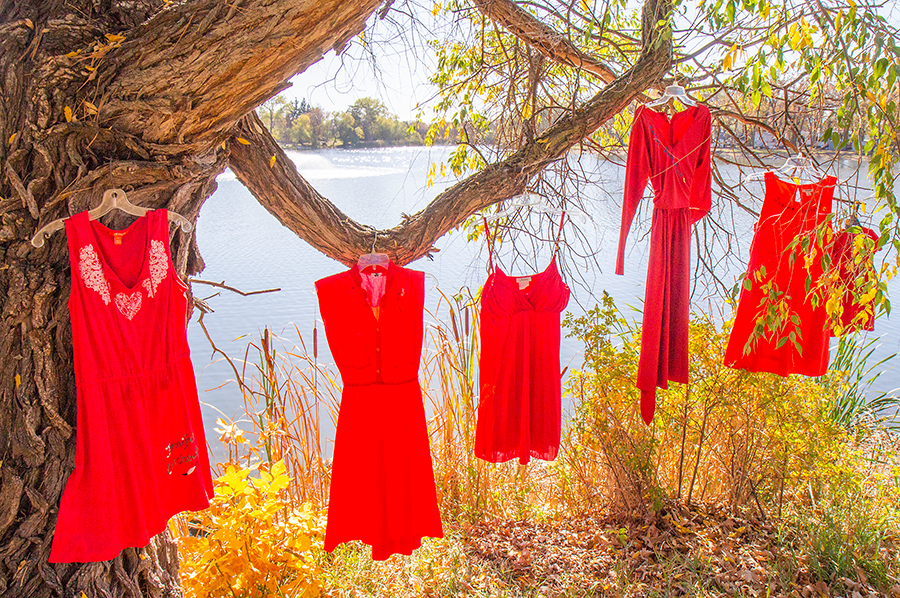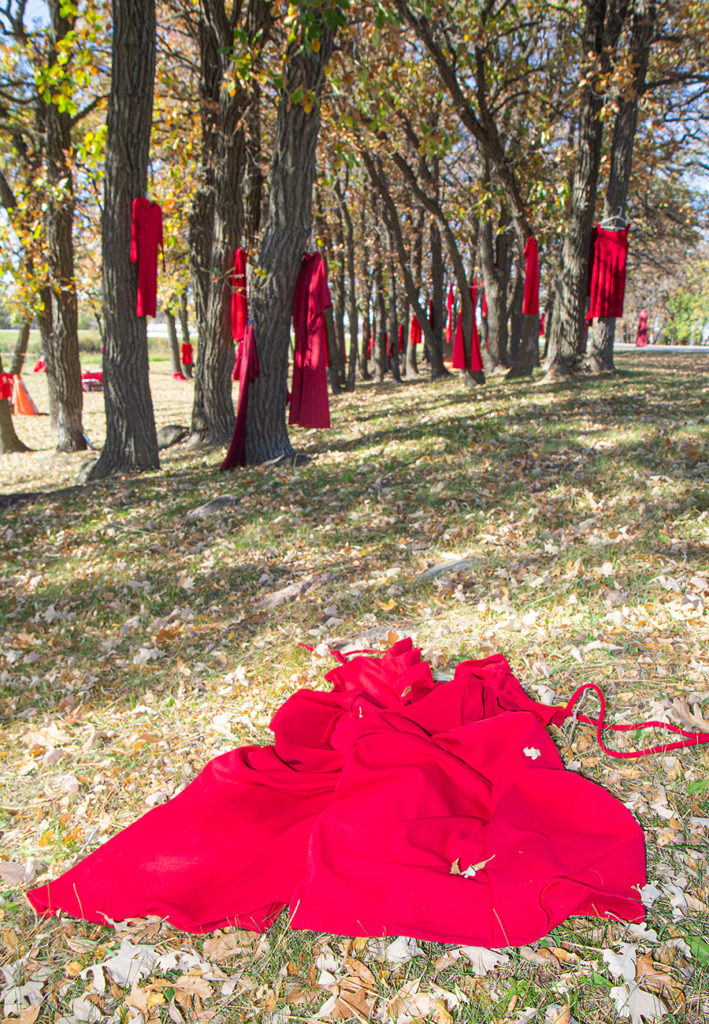
REDress Project honours victims and their spirits through the colour red
BY KIM LANGEN
It may have been the most beautiful location in the province for the gently waving red dresses, and the spirits that accompanied them.
For just five hours on Saturday, October 2, the slowly shifting garments, many of them embroidered with the names of missing or murdered Indigenous women in Manitoba, were hung on display within the oak forest park beside the bay on Park Street.
And then they were gone – like the women they represented.
Winnipeg artist Jaimie Black, creator of the REDress Project, was told by an Indigenous friend years ago that red is the only colour that the spirits can see.
“Red is really a calling back of the spirits of these women, and allowing them to be among us, and have their voices heard through their family members and community,” she was told.
“It is a visual reminder of the staggering number of women who are no longer with us,” said Black, a multidisciplinary artist of mixed Anishinaabe and Finnish descent. “Through the installation I hope to draw attention to the gendered and racialized nature of violent crimes against Aboriginal women, and to evoke a presence through the marking of absence.”
Members of the Pembina Valley REDress Project put together this particular exhibition, and the Killarney stop was the last one in their summer tour in the area, said member Denise Thiessen.
“It has been an emotional week and summer for sure,” said Thiessen, who was smudging beautifully scented sage in a bowl on her table laid out near near the bay. “These garments came from Genesis House, a women’s refuge based in Winkler, which has served the Pembina Valley area for decades, and from local donations. When you see the dresses moving in the wind, it represents a spirit dancing. Jaimie believes that red is the colour that the spirits can see when people die.”
When asked, where are these hundreds of missing and murdered women and children? Thiessen said there are many possibilities.
“They can be taken for sex trafficking, and some are dumped into the Red River,” she said. “The clothing and material that is lying behind us here on the shores of the bay is to symbolize the Red, in Winnipeg, where women have been found.”
When asked what people can do to help make change in some way, Thiessen had a few ideas.
“Just asking these questions would be good,” she said. “They can address the stereotypes, and start having conversations. This issue touches both our nation, and local communities, right here in the Pembina Valley.”
Some 1,100 Indigenous women and girls have been reported missing or murdered in Canada, but the number itself may be much higher, said the group.
And although Indigenous people in Canada make up only 4.3 per cent of the population, Indigenous women make up 16 per cent of all female homicide victims in the country. They also make up 11 per cent of Canada’s missing women.
In addition, Indigenous women are three times more likely than non-Indigenous women to be victims of violence.

LUMINOUS REMINDER OF SO MANY LOST WOMEN – A stunning display of red dresses waved gently amongst the oak trees across from Royal Manor on Saturday, part of the REDress movement to honour the shocking loss of some 1,100 missing and murdered Indigenous women in Canada. This moving art installation, created originally by Winnipeg artist Jamie Black, was on exhibition here for just five hours, thanks to the Pembina Valley REDress Project. It was their last show in the southwest tour, and reactions to the poignant and vivid display of garments and tributes were both deeply visceral and emotional.

PEMBINA VALLEY REDRESS PROJECT – Denise Thiessen (left), along with her daughter-in-law Courtenay Yeo-Thiessen, began arranging the Pembina Valley REDress Project installation early on Saturday morning, across from the Royal Manor senior apartments. Around 10 a.m., visitors began walking amongst the trees, and the stirring dresses, in an atmosphere of both beauty and loss.

SMALL SHOES TO REMEMBER THEM BY – The REDress installation in the park by the bay on Saturday also included this array of children’s shoes. The display was to honour the children of the Kamloops Indian Residential School, while the orange t-shirts on the big rock reflect the ones that local students wore to school last week, to acknowledge the first National Day for Truth and Reconciliation in Canada on Thursday, September 30.

THE MISSING INDIGENOUS WOMEN – These garments, laid on the edge of the Bay on Saturday, symbolize murdered Indigenous women who have been found in and on the edge of the Red River in Winnipeg. Some 1,100 First Nations women and girls across Canada have been reported missing, or have been victims of homicide.

SPIRITS AMONGST THE OAK TREES – Red dresses, symbolizing lost Indigenous women and children, hung silently amongst the burr oaks on Park Street on Saturday. Part of the REDress installation project, the disturbing yet beautiful garments were placed there to represent the spirits of those whose lives have been taken.
KIM LANGEN/KILLARNEY GUIDE PHOTOS

